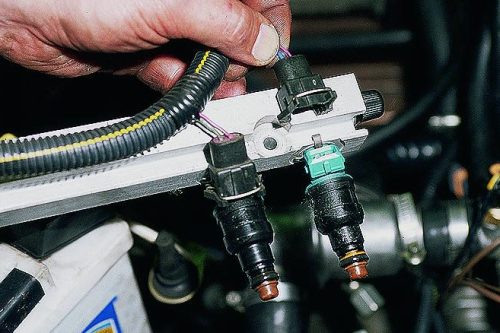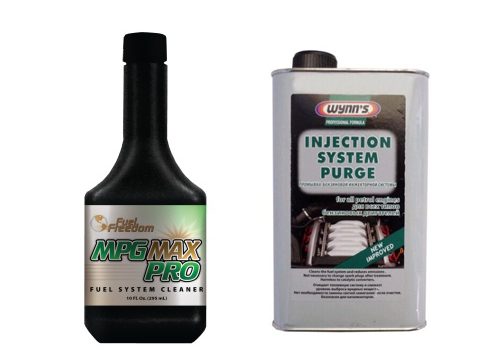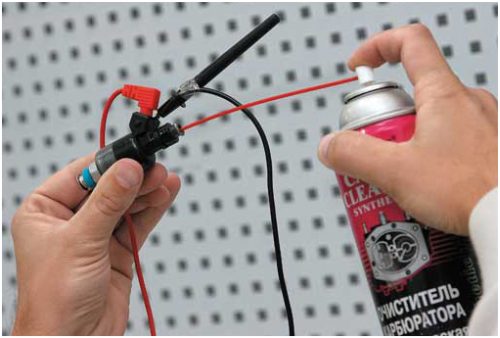Ways for self-washing diesel and gasoline fuel system
In the process of operation of the car, it does not matter, diesel or gasoline, in the intake tract and in the combustion chamber, all sorts of resinous and varnish deposits are gradually accumulated, which over time can cause serious problems. To remove them, a periodic flushing of the fuel system is required. Depending on which time intervals this procedure is carried out, various methods apply.
Causes and consequences of deposits
The main cause of pollution of the fuel line is not enough high quality of domestic fuel. According to statistics, Russian car owners faced this problem several times more often than European.
The fact is that in the fuel of domestic production contains a much larger amount of sulfur and other impurities than the European norms allow. In addition to the fact that when combustion, such petroleum products are stronger than the atmosphere, they clog and. The initial fractional composition of fuel is also introduced its contribution.
The nozzles suffer from deposits especially strongly. Under the influence of high temperature (about 120 degrees) and pressure (up to 5 bar), these sediments solidify and turn into highlights that gasoline cannot dissolve. As a result, the nozzles are climbing and stop working in normal mode:
- their throughput is reduced;
- the torch spray changes the direction and shape;
- in particularly launched cases, nozzles are completely stopped functioning.
The inverse situation is possible when the nozzle is clogged in a fully or partially open state. In this case, it ceases to keep pressure and constantly pours fuel into the cylinder.
It is worth noting that the type of engine does not matter. Diesel nozzles suffer from deposits no less, especially electronic, used in Common Rail systems, working with high pressure.
The nozzles are immediately reflected on the operation of the car engine. The fuel in the cylinders begins to flow unevenly, as a result, part of the cylinders can work on an unnecessarily poor mixture, and some are rich. At the same time, the motor loses power and pickupness, it is hard to start, especially in cold weather, its "fever" when heating and at idle, increases fuel consumption.
Diagnosis
Since the symptoms described above are characteristic of other problems, it is necessary to accurately determine their cause. There are several diagnostic methods. It is preferable to remove them from the engine and check the tightness, productivity and quality of spraying on a special stand.
You can also carry out the balance of the balance using a special sensor. To do this, the sensor connects to the fuel ramp and registers the pressure level. At the time of opening the nozzle, the pressure in the Ramp drops, after which it gradually increases. Assessing the level of pressure drop at the moments of opening various nozzles, it can be concluded about their pollution.
There are other diagnostic methods, but the two presented are the most reliable.
Methods for washing
First of all, you should decide whether to remove the nozzles from the engine or not. If you do not dismantle, the complexity will decrease significantly, but in this case it will not be possible to directly monitor the quality of the work performed, the effect can be estimated only by indirect features. 
If the nozzles take off, you can, first, check them on the stand, and secondly, the result of washing will be visible.
This method has two drawbacks.
- The first is that the complexity increases greatly, it is very difficult to remove the nozzles on some engines.
- The second minus is that, most likely, it will be necessary to replace the seals themselves the injectors themselves and the fuel ramp, and in some cases the intake path, which in addition to additional expenses it leads to a further increase in labor intensity.
Washing methods
The fight against deposits can be held in three methods. They have different efficiency, therefore the choice should be based on the degree of cloghood of the fuel system.
Simplified method
The simplest and most affordable way to combat deposits with their own hands is to pour special fluid into the fuel tank and ride as usual. In this case, flushing the fuel system is fully, including the fuel tank, and not only the nozzles. Caulfuge options for these purposes a lot, the effectiveness of them can vary greatly, so it is better to get a liquid of a well-known manufacturer.

This method is suitable for eliminating small deposits with their own hands and as preventing pollution. It should be borne in mind that if the car is large, and before the fuel system is not cleaned, the flushing of the fuel tank threatens the fact that the multiple deposits on its walls will score the mesh, the fuel filter, and in the worst case - also the nozzles, i.e. The problem is only aggravated.
Therefore, the washing fluid is best to apply as a prophylactic agent after complete cleaning of the fuel system with a frequency of not more than 10 thousand km.
The advantages of this method: flushing the fuel system entirely, low cost and simplicity. The main disadvantage is that strong contaminants cannot be removed. In addition, the car owner cannot monitor the quality of cleaning.
Solvent method
If you do this at the maintenance station, a special installation that feeds the detergent solvent is connected to the fuel ramp. The system of power does not need to turn off the fuel tank. Installations are single or dual circuit. Single-mounted installation gives solvent directly to the ramp, and the fuel that takes the pump from the tank, returns back to a small circle. With the help of a two-circuit installation, fuel system washed, with the exception of the fuel tank. 
Obviously, it is preferable to use a two-circuit installation. If there is no such possibility, and the fuel line is strongly contaminated, it is necessary to wash the ramp at first to remove the dirt out of it and do not score the finally nozzle.
With solvent, you can rinse the nozzles and independently. To perform the work with your own hands, you will need to get a wash liquid, a new fuel filter, fuel hoses for the sledding of solvent and the removal removal via the "return" and the submersible type fuel pump that is powered by the battery.
It can be saved on the pump, making an independently supercharger of a siphon type, in which the pressure of 3 atm will be maintained using a pump or compressor. A plastic canister is suitable for this purpose with a tightly screwed lid. It is necessary to bring hoses to injected air and fence fluid.
Washing is performed as follows:
- Pressure pressure in the system (the gas tank cover opens, removed).
- Starter turns on to strive pressure in the fuel ramp.
- A hose from the submersible pump or the supercharger is connected to the ramp through the filter, the hose into the container with solvent is displayed from the "return" of the fuel ramp, where the pump is located. If a siphone supercharger is used, the "return" must be drowning.
- The fuel pump is turned on or the pressure is injected, and the motor will start.
- It is necessary to give the engine to work 15-20 minutes, after which itching. After another 15-20 minutes, again start and give to work until the solve is complete. Then it is advisable to pour some pure gasoline and give a motor for a few more minutes.
At the end of the washing, the disconnected hoses are reappeared to the fuel ramp.
Similarly, flushing the fuel system of diesel. The only difference is that for a diesel engine there is no need to acquire a separate fuel pump or make a supercharger. In order to submit a detergent into the nozzles, you need to turn off the fuel supply hoses from the tank and the "reversal" from the TNLD, and instead, connect bought in the store. The opposite ends need to be omitted into a container with solvent, pre-fixing the fuel filter fuel filter hose.
Flushing of the fuel system of a diesel engine with this method gives the best result, rather than washing the ramp and nozzles of the gasoline motor. The diesel engine is washed with the entire fuel line.
It should be borne in mind that the cleaning fluid can adversely affect the engine oil, although manufacturers argue that the oil from the solvent falls does not lose its properties. Therefore, it is desirable to combine flushing with oil replacement. In addition, as a result of the procedure, the ignition of the gasoline engine can come into disrepair, so it is desirable for washing to use the backup kit.
Cardinal method
The most radical way to remove deposits from the injectors of a gasoline or diesel engine is associated with their dismantling. As a rule, it is resorted to it, if after washing the fuel system with solvent, the nozzles continue to work with interruptions. 
In the conditions of the auto repair nozzle are cleaned on the stand with ultrasound or detergent. You can perform cleaning and your own hands. To do this, you will need a liquid for cleaning the carburator type "carbcleaner" (any and for gasoline and for diesel nozzle), a small piece of hose from a gas-resistant rubber, the inner diameter of which is approximately equal to the diameter of the nozzle, clamps, tape. It is also necessary to take care of how to supply voltage from the battery to the removed nozzle.
The procedure is performed as follows. The nozzle removed from the engine is inserted into the segment of the hose and is delayed by a clamp. The tube from the detergent-liquid can be wrapped with a tape so that it is tightly inserted into the hose on the other hand, insert and also tighten the clamp. 
Wash more convenient with the helper: one of the washing will be pressed on the valve of the can, and feed the cleaning fluid into pressure in the nozzle under pressure, the second is to impulse the voltage to its contacts. The constant supply of voltage can cause a breakdown in the winding of the solenoid valve.
Flushing is performed in several cycles: the washing fluid is supplied - the dirt is faded - the means again. As a rule, the effect of such cleaning is no worse than which one can achieve in a car service on the stand. If the deposits are so solid that they cannot remove them, there are two options: try to remove them with ultrasound or buy a new nozzle.










